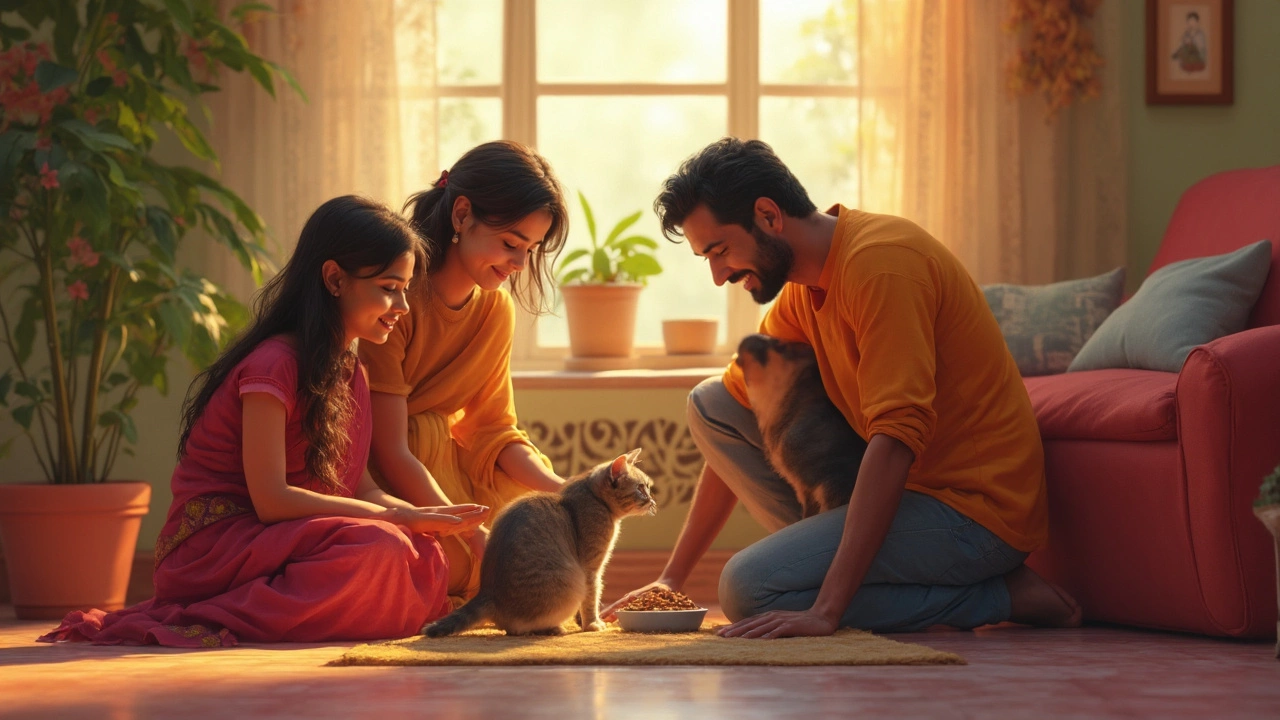
Ever catch yourself wondering if topping up your cat's bowl with wet food could actually buy them more years by your side? It's a question that pops up a lot, especially when you're in the pet food aisle and faced with way too many options. The truth is, diet really can play a big role in how healthy—and how long—our furry buddies stick around.
The main thing people talk about with wet food is moisture. Cats don't always drink as much water as they should, especially older ones, and dehydration is no joke for their kidneys and bladder. Wet food helps make sure they're getting extra fluid with every meal, almost sneaking in hydration without them noticing. This matters because kidney issues are one of the top reasons cats end up at the vet as they age.
But wet food isn’t some magic potion. A longer, healthier life depends on lots of stuff—genes, exercise, regular vet checks, and yes, what goes in their bowl each day. Still, knowing what wet food brings to the table can help you make smarter choices. If your cat already eats mostly dry kibble, you might be curious if swapping or mixing in wet food is worth the effort (and the price tag).
- What Makes Wet Food Different?
- Does Diet Really Affect Lifespan?
- Wet Food Pros (and a Few Cons)
- Tips for Feeding Your Cat Wet Food
What Makes Wet Food Different?
Wet cat food stands out mostly because of the moisture—sometimes as much as 75-80% water, compared to the very dry crunch of kibble. That huge jump in water content helps cats who just don’t seem interested in hanging out at the water bowl. This is a big deal for keeping their kidneys and urinary tract healthy, especially since cats naturally have a low thirst drive.
Another difference you'll notice is in the texture and smell. Wet food just has a stronger scent and a softer texture, which tends to attract even picky cats or seniors who might turn their noses up at hard kibble. Texture matters a lot for older cats with dental problems—they don’t have to struggle or give up on eating altogether. You get fewer leftovers and less waste when your cat actually eats what you serve.
On the nutrition side, wet food often has more protein and fewer carbs than most dry formulas. Since cats are what’s called “obligate carnivores,” they need that dense protein to keep their muscles, skin, and coat in good shape. Carbs don’t do much for them, digestion-wise, so a high protein-to-carb ratio is a win.
- High moisture content (up to 80%) supports hydration and kidney health.
- Softer texture is easier on aging teeth and appeals to picky eaters.
- Usually contains more protein and fewer fillers or carbs.
- Stronger smell can help cats who’ve lost appetite due to age or illness.
One thing to watch for: wet food goes bad faster. If your cat grazes or you’re not home often, it may dry up, smell, or attract bugs. Still, for daily meals and keeping your cat healthy, wet food delivers some real, practical benefits.
If you’re set on helping your cat live their best, longest life, knowing what sets wet cat food apart is step one.
Does Diet Really Affect Lifespan?
If you want the quick answer—yes, what your cat eats does influence how long they might stick around. That said, it's not as simple as "just feed them wet food and they'll live forever." Diet is one piece in a big puzzle that includes genetics, exercise, regular vet care, and lifestyle.
Still, nutrition impacts their immune system, organ health, weight, and even how active your cat feels. For example, giving your cat too many treats or foods with lots of fillers or carbs can put them at risk for obesity, diabetes, and urinary issues. On the flip side, high-quality food with real protein and enough moisture can support major organs, especially the kidneys and bladder—which are weak spots for a lot of cats as they age.
Several vets and actual studies back this up. According to a 2023 AVMA survey, cats on a high-quality, balanced diet (wet or dry) tend to live up to 15-20 years, while cats regularly fed low-grade foods or table scraps average less than 13 years. Wet food stands out, especially in the hydration and protein department, which helps counteract two giant problems for older cats: kidney disease and constipation.
| Diet Type | Average Lifespan (years) |
|---|---|
| Mostly high-quality wet food | 16.2 |
| Mix of wet and dry | 15.4 |
| Mostly dry kibble | 14.7 |
| Low-grade or table scraps | 12.8 |
So, does this mean you have to switch completely to wet food to squeeze out a couple more years? Not really. What's more important is giving your cat complete, balanced food—meaning all the nutrients they need, in the right amounts. But adding wet food does give that extra boost for hydration, which is a game-changer for things like kidney health.
Here's what actually makes the difference for a longer, healthier life:
- Choose a cat food with real meat or fish as the first ingredient.
- Check for complete balanced nutrition (look for "AAFCO" on the label).
- Make sure your cat stays hydrated—wet food helps, but always have fresh water out.
- Avoid overfeeding, even if your cat acts super hungry.
Bottom line: The right food absolutely matters. It's not the only thing, but it gives your cat the best shot at a good, long life.

Wet Food Pros (and a Few Cons)
There's a bunch of reasons people swear by wet food for their cats. First off, it's a hydration hero. Cats are notorious for skipping their water bowl, but every serving of wet food packs a lot of moisture. That extra water is great for their kidneys and can help fend off urinary tract issues. That's a big deal, especially for older cats who are more prone to kidney problems.
Another plus: wet food usually smells and tastes stronger than dry kibble. For picky eaters or cats with low appetite, that's a lifesaver. A cat who ignores their dry food might dig right into a meaty, smelly can of wet food. It also tends to be easier to chew, making it good for cats with dental pain or senior cats whose teeth aren’t what they used to be.
When it comes to nutrition, many wet foods are closer to what cats eat in the wild. There's generally more protein and fewer carbs, which lines up better with what felines actually need. If you manage portion sizes, it’s easier to keep your cat at a healthy weight—some studies have linked wet food diets with lower obesity rates in cats.
- Cat food choices really matter when it comes to balancing health, taste, and hydration.
- Wet food helps with kidney and urinary tract health by boosting water intake naturally.
- It's highly palatable and digestible, which can be a game changer for picky or sick cats.
- Common recipes have fewer fillers and more animal-based protein compared to bargain dry kibbles.
Now for the cons: wet food is messier and needs to be refrigerated after opening. If a cat grazes all day, you can't leave wet food out for hours or it'll spoil. It’s also pricier than dry food, especially if you have multiple cats or big eaters. Plus, some cats can get fussy and demand only the expensive stuff once they get a taste. Not all brands are created equal either—some cans are loaded with unnecessary fillers or added salt. Always check the ingredient list before filling up your shopping cart.
Tips for Feeding Your Cat Wet Food
Switching to wet food or just adding it into your cat’s routine can make a real difference if you do it right. Cats can be stubborn about change, and some have sensitive bellies, so don’t rush it. Here’s how you can make the switch smooth and actually get the health perks you’re after.
- Start slow. Mix a little wet food with your cat’s usual dry food at first. Keep the ratio low, maybe a quarter wet to three-quarters dry, and raise it over a week or two. This helps avoid any tummy trouble and gives picky cats time to adjust.
- Stick to a schedule. Wet food can spoil faster than dry food. Put it out at mealtimes, and pick up leftovers after about 30 minutes, especially in warm rooms.
- Pay attention to calories. Wet food can make it easier to control portion size since most cans and pouches list calories. Use a kitchen scale or measuring spoon if your cat’s on the rounder side. An average adult cat needs about 200-250 calories a day.
- Get the right texture. Some cats love shredded or pate, others prefer gravy. Test a few styles before committing to a big box. You don’t want to fill your pantry with food your cat won’t touch.
- Watch for water intake. Wet food packs a punch in moisture: most have around 75-80% water compared to 10% in dry food. This is great for urinary health but make sure your cat still has access to fresh water, too.
| Food Type | Typical Moisture Content | Shelf Life After Opening |
|---|---|---|
| Wet Food (Canned/Pouch) | 75-80% | 2-3 days (refrigerated) |
| Dry Food | 8-12% | Several weeks (sealed) |
One last thing: always read the ingredient list. Go for wet foods that have real meat or fish listed first and avoid ones packed with fillers like corn or vague "meat by-products." Your cat’s gut will thank you.
The bottom line? Feeding your cat wet food doesn’t have to be a hassle, and making these small tweaks could keep them around (and healthy) for more of those weird late-night zoomies.


